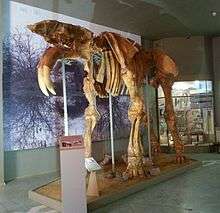Azov History, Archaeology and Paleontology Museum-Reserve
Azov History, Archeology and Paleontology Museum-Reserve, situated in the town of Azov in Rostov Oblast region of Russia, is one of the biggest southern museums of Russia hosting the richest paleontological collection in the South of Russia. The museum was established on 17 May 1917 by Michail Aronovich Makarovskiy. The 168 employees work in the museum, the 29 of them have an academic degree,[1] staff members carry scientific researches and their works are published in scientific journals.[1]
Building of the museum
The bulk of the museum is located in the three-story building erected in 1892 which belonged to the former town council, there are 22 rooms.
The museum areas: permanent exhibitions - 2852 m², temporary exhibitions - 580 m², storage facilities - 1896 m², park (open air) - 7.13 hectares.
Exhibits and funds

There are 340765 storage units, among them 206371 units of the main fund. Annual incoming delivery to the main fund averages 3780 items for the last 10 years.
The symbol of the museum is the skeleton of a Trogontherium mammoth that existed 800-600 thousand years ago in the interglacial period. This is the world’s unique skeleton with the whole skull.
Almost a half of the funds consist of archeological complexes including ones without equals of world’s museum collections. World-class values are the objects from the 1st century AB burial mounds found as a result of archeological excavations in the territory of Rostov region – works of art: gold jewellery, parts of harness, gold and silver kitchenware, weapons, ...
The museum has the largest collection of glazed ceramics of the 14th century.
The paleontology collection is the largest in the Northern Caucasus (more than 1500 items). The most popular museum exhibit is the skeleton of a Trogontherium mammoth (4.5 meters high) aged 600 thousand years, which is among several known skeletons and the unique one with the fully preserved skull of the mammoth of the species. Azov museum-reserve is the owner of another unique paleontological object - it is the skeleton of a proboscidean deinotherium aged 5 million years.
The museum keeps the finds from a rare co-location of big (beaver-trogontherium, Taman elephant, large horse, elasmotherium, Homotherium, hyenas, large elk, complex horns deer, antelope, short horns bison) and small mammals of the Eopleistocene epoch from the village of Semibalki. The findings were attributed to the Morozov horizon, Cherevichanskaya phase and Verhnecherevichanskaya association (Taman faunal complex). The geological age of these findings suggests the possibility of discovering traces of ancient human life, whose existence could have been maintained by herd herbivorous inhabitants of the steppe zone at the beginning of the Quaternary period.
Museum items are located in the 35 museum depositories.
References
- 1 2 "Публикации научных сотрудников АМЗ в 2012 г." Check
|url=value (help) (in Russian). Оф. сайт. Retrieved 2013-12-01.